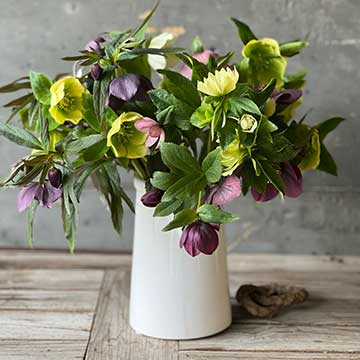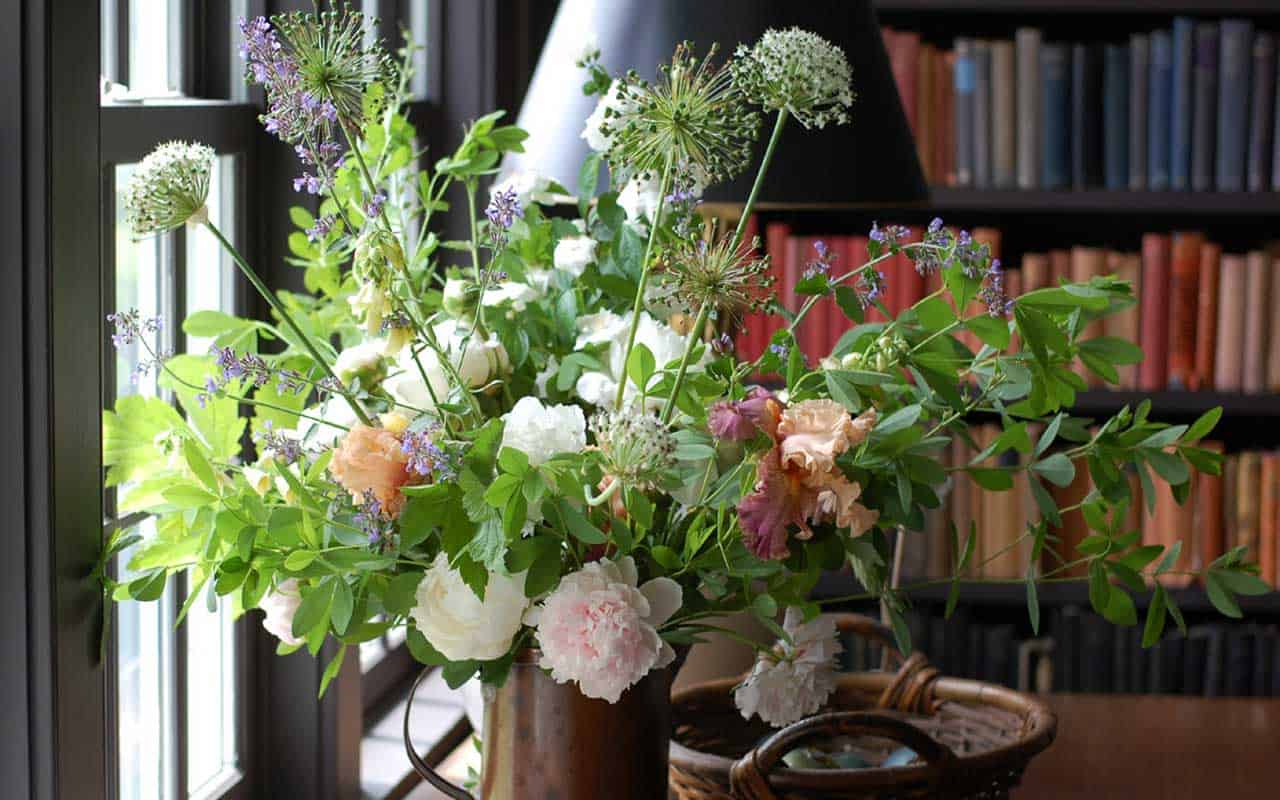Over the last year of this column, I have talked a lot about growing flowers to cut and enjoy inside your home. Growing or sourcing local seasonal flowers has become the drum I like to beat (to death my husband would say!) be it for the environmental benefits and/or the emotional joy of creating your own beauty from just a tiny seed. What we haven’t talked about though is what to do with those flowers once they are cut.
If you are hoping for an A-Z of flower arranging tips, I’m afraid you are going to be sorely disappointed. It’s not even a guilty secret – I am very upfront that I am a horrible flower arranger. My MO consists of keeping it super simple. If in doubt, go single variety, go big in numbers, and use a good-looking, size-proportional vase. That’s my limit. Luckily there is a font of knowledge to be gleaned online, on Instagram, and through any number of brilliant classes when it comes to flower arranging. One day I will find the time to delve deeper but until then, I know my limits.
 Conditioning
Conditioning
Instead, what I want to talk about today is what is generally known as conditioning. This may sound like a highfalutin floristry term but it’s really not complicated. However, it is the difference between your flowers drooping into a heap after Day 1 or lasting like troopers for days at a time. Just a little bit of the right care and attention when first cut can make a world of difference to the vase life of your flowers.
Before we start, it is worth pointing out that some flowers will last days, if not weeks once cut, others 48 hours max never mind how they are treated. So regardless of the tips and tricks below, you need to be realistic about certain flowers. For example, your sweet pea will be the first to leave the party, while a ranunculus will be dancing until dawn.
When to cut
So, now that we’ve got our expectations in place, let’s consider when to actually cut your flowers. Some flowers are best cut at a stage when they’ve barely cracked open – tulips for example. Others such as daisy and single stems – sunflowers, dahlias, and chrysanthemums – need to be just coming to full bloom when cut as they will not open more than a smidge after. Then there are the likes of hellebores, who want you to wait not only until they are fully open and then some, but until the point of setting seed if they are to last more than an hour in the vase before wilting. So, if in doubt, check with Dr. Google before setting sail with the secateurs.
Secateurs
Talking of secateurs – nice, clean, sharp blades please. You want as clean a cut as possible. The flower draws water up the cells of its stems so if it is contending with a crushed mangled dam of stem end, chances are it’s not going to be able to pull enough water up to keep itself looking tip top for very long. If you buy your flowers from a florist, grower, or farmers market, make sure the first thing you do on getting home is to recut the ends of your flowers before placing them in water – even if you think they are the perfect length already. Stem ends begin to seal over as soon as they are exposed to the air, and you want to open them up again. Cut the stems on an angle to create the greatest water-absorbing surface area. With woody stems, also make a vertical cut up the stem.
Helpful tips
The time of day you cut your flowers is also important. Please do not go out like mad dogs and Englishmen into the midday sun to do this. Cutting in the blazing July sun will do you or your flowers no good whatsoever. Early morning or evening only. And if you are cutting a lot of flowers, take a bucket of water with you to place the stems in immediately as you cut them. No Instagram-worthy wafty wicker baskets please!
Unless you are cutting or using a stem for foliage, strip any leaves off the stems. Water travels up the stem and goes to whatever it comes to first. If there’s a dozen or so leaves between the stem end and your flower head, the odds are not in your flower head’s favor. Regardless of how you are using them, once you get them in the vase, there should be absolutely no foliage below the water line.
Flower CPR
Next up, the scary bit – searing your flower stems. Do I need to? For how long? Am I going to kill my flowers? Maybe. That depends. Probably not. Searing can really help a flower draw water up its stem and so prolong its life. Do I do this on a regular basis for a jug of flowers on my kitchen table? No. Would I do it if I wanted an important arrangement to last and I knew I had some diva flowers in there? Definitely yes.
There is an argument that all flower stems can benefit from searing but personally I use this for woody stems – lilac, vibernum, spirea – and really short-lived flowers such as hellebores and sweet peas. I also do it to revive any flower heads that have completely flopped – it’s the floral equivalent of CPR.
Place around 10% of the stem length in boiling water and leave for 10 seconds for more fragile flowers or up to 30-40 seconds for woody stems. Be sure to keep the actual flower heads out of the steam. Then plunge immediately into cold water.
Finally, we get to the number one crucial step in cut-flower maintenance, what is officially known as conditioning. As impatient as you may be to get arranging, hold your horses! Skip this stage at your peril. All conditioning entails is stripping the foliage from your flower stems and placing them in a bucket of cold water as deep as possible in a cool dark room, ideally overnight but for at least a couple of hours. This way your flowers are fully hydrated when it comes to arranging them. This is the game-changer stage in vase-life longevity. Do not skip it!
Flower magic
Now all you need is a squeaky-clean vase or vessel, and you are ready to create your floral masterpiece – or kitchen table jug. Remember to keep your flowers away from fruit or vegetables and out of direct sunlight, and don’t forget to keep topping up the water levels.
Finally, here’s one last tip as we begin to enjoy peony and hydrangea days. These are notorious floppers, especially those mopheads. Should you find yourself in this predicament, despair not! Run a bath of cold water, submerge the entire flower – stem and head – under the water and leave overnight. Try it and then tell me there’s no such thing as magic. •
Pom Shillingford is an obsessive gardener originally from England and now based in Salisbury, CT. She offers seasonal cut flowers through English Garden Grown. Find her on Instagram @english_garden_grown.

